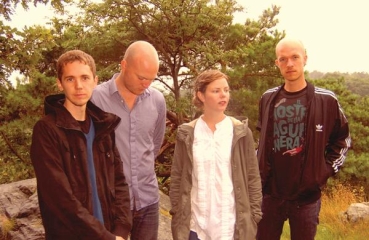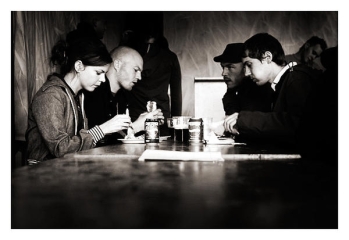
I am interested to see what this decade brings to Swedish pop music. One would be hesitant to call the ’00s a moment of global emergence for the movement, especially considering that the country has been generating quality music already for several decades. Its separable status in Western pop music is indicative of its special place though, as additional genres in pop music relative to a geographical location are often reserved for countries farther east (in other words, those eligible for the “exotic” tag). This past decade was special for Swedish pop music because it made the movement audibly identifiable, or at least open to close guesswork. That no accents or geographical quirks were present made the identification process even more impressive. Of course this does not apply to all Swedish pop artists, but certain stylistic fixtures were present and enabled many Swedish artists to find a common ground despite vast creative differences. Whether they complied with lavish string accompaniments (ABBA), awe-inspiring use of electronics (The Knife), or good old-fashioned pop music (Jens Lekman) did not matter. Gothenburg alone had Jens Lekman, The Tough Alliance, and José González to its name this past decade, and each major Swedish city seems to boast a comparable list of native sons and daughters. The Swedes may be spoiled with tons of great live music as a result, but their non-reluctance to share it with the rest of the world is the primary cause for this recent surge in recognition.
For a contemporary pop musician, to come out of Gothenburg these days must be the equivalent of trying to make it in Brooklyn. There are simply too many renowned hometown acts, and whether they make the big-time or not is fairly irrelevant. Some artists are perfectly content in being a staple of their respective locale, with the opportunity for people to listen and applause being enough motivation to continue their artistic exploits. I briefly covered this over-saturation of talent within a locale in my Kordan feature last year (in regard to Brooklyn), and a very similar case can be made for Sambassadeur. Swedes and Brooklynites share a mutual critique of sorts since they are accustomed to simply walking outside and hearing great music. So, how the hell are artists supposed to get noticed if every potential listener is a staunch critic? Good music, perhaps. Like thrusting oneself into a top-level sport, the constant competition improves one’s ego along with their actual skills until they reach a point where they truly belong. If the time never comes, well, then perhaps another occupation should be considered. For this reason I hope that Sambassadeur will receive the attention they deserve both in Europe and elsewhere, since even the most talented of musicians can call it quits due to an overpopulation of competent rivals.
 Sambassadeur was formed in 2003 within Skövde, a small town situated between Sweden’s two largest lakes. They all met in school and played gigs throughout local small towns and occasionally Gothenburg, where they are now situated. Fans began to take notice in 2005 when the four-piece released a self-titled debut and an EP, which was followed up the next year by another EP. Another album, Migration, in 2007 proved that Sambassadeur were intent on improving despite their competition. Regardless of whether their competition was receiving good or bad press, it still appeared they were receiving more than Sambassadeur. This quantitative standard may been their detriment in the early goings. The band’s ethic was never questioned, nor was their potential which illuminated brightly through insanely addictive harmonies. Their style though, not entirely innovative or unique in the vein of Swedish pop, meant that their music had to be more than good in a country where pop music reigns. It had to be exceptional. The past three years has seen little activity from Sambassadeur, who are perhaps ditching their quantitative ways in favor of a dramatic transformation that may put them in the same category as an Air France or Tough Alliance. Their new album, European, is their first release in three years and their most accomplished yet.
Sambassadeur was formed in 2003 within Skövde, a small town situated between Sweden’s two largest lakes. They all met in school and played gigs throughout local small towns and occasionally Gothenburg, where they are now situated. Fans began to take notice in 2005 when the four-piece released a self-titled debut and an EP, which was followed up the next year by another EP. Another album, Migration, in 2007 proved that Sambassadeur were intent on improving despite their competition. Regardless of whether their competition was receiving good or bad press, it still appeared they were receiving more than Sambassadeur. This quantitative standard may been their detriment in the early goings. The band’s ethic was never questioned, nor was their potential which illuminated brightly through insanely addictive harmonies. Their style though, not entirely innovative or unique in the vein of Swedish pop, meant that their music had to be more than good in a country where pop music reigns. It had to be exceptional. The past three years has seen little activity from Sambassadeur, who are perhaps ditching their quantitative ways in favor of a dramatic transformation that may put them in the same category as an Air France or Tough Alliance. Their new album, European, is their first release in three years and their most accomplished yet.
Although this is significantly varied, the third full-length always seems to be a make-or-break point in a band’s career (at least in terms of critical respect and praise). Most critics and listeners have sympathy for a sophomore slump, mainly because we can all relate to attempting to exceed expectations and meeting a deadline simultaneously. The third album, though, seems fair game even if its predecessor is hailed as a masterpiece. Sambassadeur’s third album is fortunately their best yet, as sweeping gems like “Days” and “Albatross” indicate on their own. The group takes advantage of their conventionalized, pop-minded structures by employing fluttering instrumentation in an effort like “Days”, where operatic strings combine with high-pitched keys for a sound both ethereal and briskly seasonal (when the sun is shining). Anna Persson’s graceful voice is accentuated when only accompanied by acoustics and bass, reminding listeners that elaborate strings are not always used to disguise flaws. “I just have to know you’re coming back again,” she concludes the song, ending it on both an optimistic tone that has a touch of unrequited bitterness to it. “I Can Try” is just as fun, this one borrowing from local legends ABBA in their use of descending arpeggios and accessibility. The synthesized crystal-like effect that appears to grace itself under Persson’s vocals are a nice tough, appearing subtly enough to establish its hook-worthy presence. Some things are used better in moderation and this is one of them.
“Albatross” is a unique step forward for the group. The tone of this track is ultimately more engrossing than any others they have released, and Persson’s vocals are implemented perfectly as the cohesive warmth of exuberant strings collides over the reverb-heavy percussion and vocals. This is the sound that jj was apparently attempting on jj nº 3, only to fail by grasping for straws. Sambassadeur’s “Albatross” succeeds immensely though. There is little structural variation to speak of, but those looking for defiant orchestral compositions are going to be disappointed by the first track anyways. What this track, and so many others on European succeed in is an incomparable ability to tread on both the tragic and uplifting. It recalls the same vein of polished pop that makes other Swedish symphonic-pop so memorable. It is the emotional depth here that should propel Sambassadeur to the eyes and ears of many though. Persson speaks of avoiding “travel and delays” because of a romantic hindrance, the elegant and sympathetic work of strings doing the weeping behind her. As her vocals begin to repeat and fade out, a wondrous string accompaniment emerges to serve as the backbone of the track until its completion. The structures and topics may not be groundbreaking here, but Sambassadeur are gradually expanding their own boundaries to become the next big thing in Swedish pop.
——————————————————————————————
[audio:http://mineorecords.com/mp3/samb-alb.mp3]——————————————————————————————
[audio:http://mineorecords.com/mp3/samb-day.mp3]——————————————————————————————
[audio:http://mineorecords.com/mp3/samb-ica.mp3]——————————————————————————————






;)* thanx so much!did you know, when i try to fwd this blog’s entries to facebook, facebook dissallows them..?which is a mystery, as i share blog input with facebook all the time without this ‘warning from facebook’, which claims inapropriate content..?so, someone, at some time has ‘dobbed you into facebook for some reason, or other..?anyway, won’t stop me tryin’, anyway, it ‘shares’ with every other ‘outlet’ i try, so it’s facebook’s loss! ;)*
thanks for the heads up milli. i don’t know why facebook is flagging the site as inappropriate, but i’ll look into it.
this site isn’t even blocked on the majority of site blockers, and I’ve seen pictures on facebook that are a bit more offensive than my content 😉